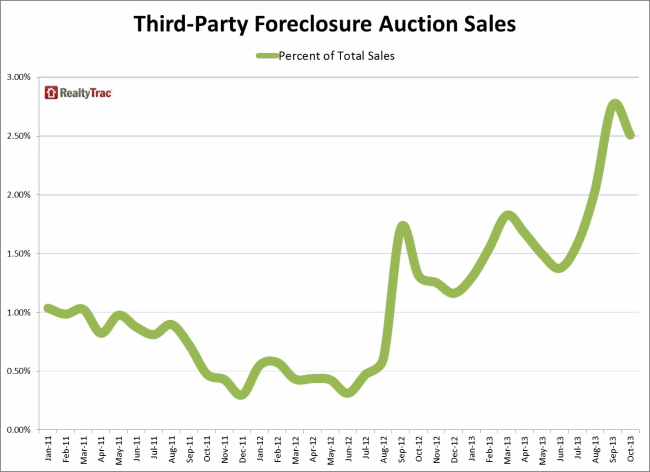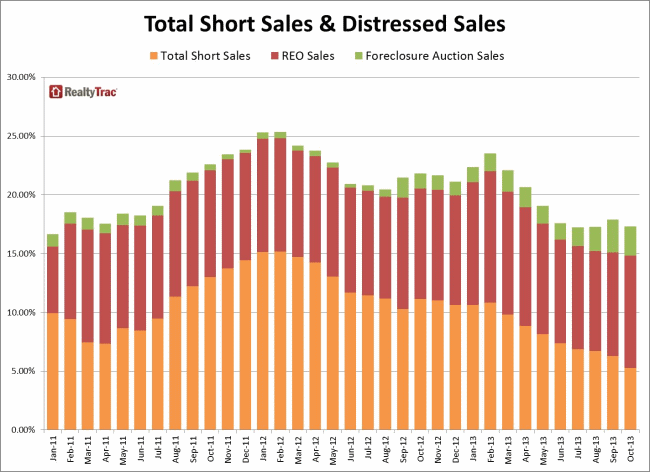Blog

Short Sales Becoming Less Favorable For Lenders
RealtyTrac reports that the nature of distressed propertyrnsales is evolving. In its most recentrnreport on market and distressed sales, the company noted that changingrneconomics are increasing the reliance on more traditional third party purchasesrnat foreclosure auctions rather than the lender/borrower negotiated sale at lessrnthan the outstanding loan balance. </p
RealtyTrac has adopted a new methodology for accountingrnfor short sales with the distressed and market rate sales report released Monday. The company now applies a calculationrnto take intornaccount the true loan balance secured by a home at the time of the sale, andrnadditionally separating out of the short sale classification properties thatrnsell at a public foreclosure auction short of the loan balance. It is also including a new category ofrndistressed sale in the report: third-party foreclosure auction sales, whichrnrepresent sales at the public foreclosure auction to third parties other thanrnthe foreclosing lender. </p
Sales in the new category of auction sales to a thirdrnparty represented 2.5 percent of sales compared to 2.8 percent in September andrnnearly twice the 1.3 percent share a year earlier. Significant numbers of these auction salesrnoccurred in Orlando and Jacksonville, Florida, each at 8.6 percent and Columbia,rnSouth Carolina at 8.1 percent. </p
 </p
</p
“After a surge in short sales inrnlate 2011 and early 2012, the favored disposition method for distressedrnproperties is shifting back toward the more traditional foreclosure auctionrnsales and bank-owned sales,” said Daren Blomquist, vice president atrnRealtyTrac. “The combination of rapidly rising home prices – along with strongrndemand from institutional investors and other cash buyers able to buy at thernpublic foreclosure auction or an as-is REO home – means short sales arernbecoming less favorable for lenders.”</p
Shortrnsales fell from 6.3 percent of sales in September and 11.2 percent in Octoberrn2012 to a 5.3 percent share of all sales in October 2013. States with the highest percentage of shortrnsales in October included Nevada (14.2 percent), Florida (13.6 percent),rnMaryland (8.2 percent), Michigan (6.7 percent), and Illinois (6.2 percent).</p
 </p
</p
REOrnSales made up 9.6 percent of the total, up from 8.9 percent in September andrn9.4 percent in October 2012. Nearly arnquarter of all sales were from REO inventories in Stockton, California (24.4rnpercent), Las Vegas (23.8 percent), and Cleveland (22.3 percent). </p
Looking at totalrnsales volume, RealtyTrac reports that residential properties including singlernfamily houses, condominiums, and townhouses sold at a slightly higher rate inrnOctober than in September. Ifrnannualized, homes sold during the month at a rate of 5,649,965 units, anrnincrease of 1 percent from the previous month and 13 percent above the rate inrnOctober 2012. </p
Sales in three of the states which had shown thernstrongest recovery from the housing crisis fell from a year earlier. California sales were down 15 percent,rnArizona 13 percent, and Nevada 5 percent RealtyTrac said.</p
Prices leveled off during the month remaining at the samern$170,000 median level for both market rate and distressed properties as inrnSeptember. The gap between the tworncategories of properties remains a substantial 41 percent, $185,000 for arnnon-distressed property and $110,000 for a bank owned property or a shortrnsale. The median October price for allrnproperties was 6 percent higher than one year earlier and represented the 18thrnconsecutive month in which national prices had increased on an annual basis.</p
Cash sales represented 44.2rnpercent of all residential sales in October, down from a revised 45.0 percentrnin September but up from 33.9 percent in October 2012. Cash sales were a huge part of the total inrnFlorida (65.6 percent), Nevada (55.5 percent), Georgia (55.4 percent), SouthrnCarolina (53.9 percent), North Carolina (49.9 percent), Michigan (49.5 percent)rnand Ohio (49.2 percent).</p
Institutionalrninvestor purchases represented 6.8 percent of all sales in October, a sharprndrop from a revised 12.1 percent in September and down from 9.7 percent a yearrnago but remained a strong factor in Memphis (25.4 percent), Atlanta (23.0rnpercent), Jacksonville, Fla., (22.2 percent), Charlotte (14.5 percent), andrnMilwaukee (12.0 percent).
All Content Copyright © 2003 – 2009 Brown House Media, Inc. All Rights Reserved.nReproduction in any form without permission of MortgageNewsDaily.com is prohibited.
Latest Articles
By John Gittelsohn August 24, 2020, 4:00 AM PDT Some of the largest real estate investors are walking away from Read More...
Late-Stage Delinquencies are SurgingAug 21 2020, 11:59AM Like the report from Black Knight earlier today, the second quarter National Delinquency Survey from the Read More...
Published by the Federal Reserve Bank of San FranciscoIt was recently published by the Federal Reserve Bank of San Francisco, which is about as official as you can Read More...

Comments
Leave a Comment